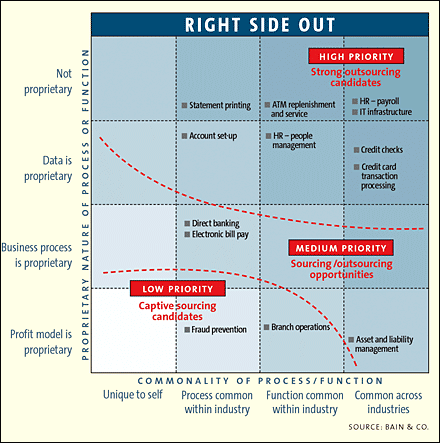I come from a point of view that says, at the end of the day, 80 percent of business is the same, so you ought to focus your energy on the 20 percent that’s different. I’ve listened to countless executives over the years who say, “You don’t understand, we’re different, we’re unique.” So I ask them whether there’s any value to that uniqueness? You want to get your value from the 20 percent, not the 80 percent. So I should source that 80 percent from the best place at the right cost, and focus all my energy on the 20 percent that really makes the difference. But how do you tell which is which?
If you sit in the exit row of an airplane, the flight attendant will come up to you and ask, “Are you willing and able to open the door in case of an emergency?” That’s the same question CIOs should ask when considering outsourcing. We have a diagnostic tool to help with making that decision.
So if I’m thinking about outsourcing, I ultimately want to understand whether or not the business process I have in mind can be leveraged onto an industry infrastructure—in other words, can I share it? That’s the horizontal axis, the “Am I able?” axis, and it ranges from processes unique to myself, to processes common within the industry, to processes common across all industries. The payroll process, for example, is common across all industries. The vertical axis, the “Am I willing?” axis, is the proprietary nature of the process. By sharing it, am I giving up company secrets and critical information that I should never put on a shared platform? In the upper right-hand corner are the functions and processes that you should be both willing and able to share, because they’re highly common and shareable. The stronger outsourcing candidates will tend to fall into that corner. The processes that fall in the lower left-hand corner are the ones I’m neither willing nor able to share—meaning they’re heavily proprietary, or it’s particularly unique—so they’re not good candidates for outsourcing.
When you cut through it all, it’s really about the degree of control you need. Do you need to own it to control it, or are you comfortable with contractual control? And, if the latter, will you have the physical proximity you need? There are certain high-touch processes where the physical proximity has to be very close. But there are also some processes that can be digitized and that allow me to begin to create the world of “as if.” It’s “as if” the claims-processing center were in the basement, it’s “as if” I’m sitting here having a conversation with the claims agent, even though she’s 600 miles away. It’s “as if” I’m in the store when I’m actually shopping online. Thanks to technology, the world is becoming more “as if.”
